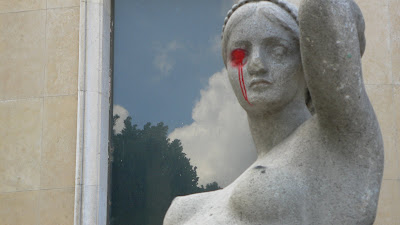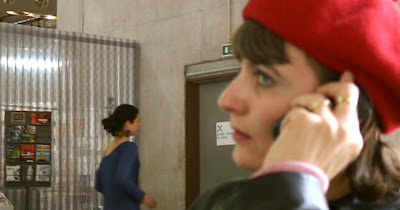31 May 2007
30 May 2007
29 May 2007
24 May 2007
23 May 2007
22 May 2007
21 May 2007
20 May 2007
19 May 2007
18 May 2007
17 May 2007
16 May 2007
15 May 2007
Rainy day

Zo & les Dents de Scies.
French band, new album 'Sous mon pébroque', next gig : June 5th.
Info + mp3 + videos +++ : here
13 May 2007
11 May 2007
Perfection
 "Nighthawks", © The Art Institute of Chicago.
"Nighthawks", © The Art Institute of Chicago.Notice the way Edward Hopper achieves his effects. There is a difference between the painting's Nodal Point (the point where the lines of the painting converge) and the Focal Point (the place where the eye is finally drawn to). The long insistent diagonal of the cafeteria crosses with the diagonal of the street on the left side of the painting. Normally X marks the spot, and that intersection where the planes collide is where the eye would typically be directed, but Hopper grabs the attention away from the left of the picture and pulls the eye to the extreme right via the acid yellow lighting and the lady in the red dress. One of the reasons he can mute the focus on the streetcorner is that he cheats on the perspective, making the sidewalk impossibly wide and the street impossibly narrow. The vamp is definitely the Focal Point of the painting, but her distance from the visual center helps make her isolation more pronounced.
So too do our eyes follow the diagonal trail of reflected in the Automat's window. However, the lights lead to nowhere, a black void, and so our eye drops down to the girl framed in shadow drinking coffee alone; the night is cold enough that she's still wearing one glove (note the tiny radiator trying to heat the big room with plate glass windows). Again, this distance between the Nodal Point and the Focal Point helps reinforce the subjects loneliness and alienation.
Some critics mention a connection to Hemingway in the Nighthawks, and we think the comparison is apt. Both the writer and the painter shared an economy of style, clean and uncluttered, with a sense of deeper meanings lurking below the surface. We've always read the diner as offering a kind of sanctuary for these lonely city dwellers. These are not barflies, after all. Its a testament to how important it is to have a nice quiet place to go late at night when things are tough and you just need a cup of coffee. The beauty of Hopper is that he's open to various interpretations, so much so that plays have been written about what is transpiring in that diner.

Swiss Diner
08 May 2007
07 May 2007
The President The French Will Love To Hate
 Yesterday, Nicolas Sarkozy was elected president of France. This morning, the writing was on the wall: "Sarkofage" — a pun on his name (OAD: "SARCOPHAGUS: a stone coffin, typically adorned with a sculpture or inscription and associated with the ancient civilizations") In French, this is called "double entendre."
Yesterday, Nicolas Sarkozy was elected president of France. This morning, the writing was on the wall: "Sarkofage" — a pun on his name (OAD: "SARCOPHAGUS: a stone coffin, typically adorned with a sculpture or inscription and associated with the ancient civilizations") In French, this is called "double entendre."









































